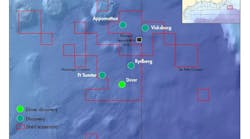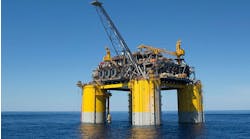Dr. Richard Morgan
Veritas
Two recently announced discoveries in the deep to ultra deepwater Niger Delta are sure to re-ignite interest in this region following a lean period that saw four deepwater wells drilled, apparently without locating commercial quantities of hydrocarbons.
It has been reported that Bobo-1X in OPL 322 and Etan-1X in OPL 245 found 140 m and 120 m of oil-bearing reservoir, respectively, providing a much-needed boost for the exploration effort currently focused on the deep and ultra deepwater slopes of the delta.
Exploration confidence had taken a knock with a succession of unsuccessful deepwater tests, and possible causes under consideration include a limitation to the area of suitable generative source rock. Such a problem could write off large areas to further exploration, and so the successes in OPLs 322 and 245 have served to diminish this risk substantially in both the southern and the western outer thrust belt areas. However, if lack of generative source rock is not the cause, then what are the other likely factors that determine success or failure in this region?
The ultra deepwater slope area of the Niger Delta has become one of the world’s exploration hotspots. Previously, the advance of exploration off the shelf and onto the slope area of the Niger Delta produced a succession of major discoveries -Erha, Bonga, and Akpo to name a few - and hopes have been high for a continuation of this success further downslope.
Expectations for the area have been enhanced by experiences offshore Angola, where the direct detection of hydrocarbons using seismic data provided a high drilling success rate in a similar environment, at least for a period of time. Discounting the fearsome water depths (1,500-3,000 m), exploration has progressed and a number of ultra deepwater wells have been drilled over the last year, although unofficial reports suggest these wells have met with mixed results.
On the higher levels of the slope, in typically 500-1,500-m water depth, the positions of existing deepwater fields such as Bonga, Aparo, and Bosi are characterized by large, discrete folds formed above deep-rooted thrust faults. The reservoirs are typically an amalgamation of many individual sand-filled channels or more laterally extensive sand-prone splays at the down-slope ends of levee-bounded channels.
The slope channels are beautifully imaged on seismic data and the complex of individual channel elements, cut-banks and point bars are all readily identifiable in modern 3D data. The channel mouth splays are more difficult to see in seismic data but as these occur at down-slope end-of-channel complexes, it is relatively straightforward to know where to look.
Down-slope from the proven areas the stakes are higher, not only because of the technology-stretching water depths, but also due to important changes in the geological setting. The same submarine channel systems are seen to continue into the lower slope region, but the thrust faults, above which the folds have formed, originate from a shallower level or detachment. This means that the folds in these areas are tighter and steeper-limbed, making the closure areas smaller. In order for these to work as traps, the sand-bearing channels and frontal splay fans must be found within them.
With the movement of exploration interest downslope another significant unknown has been the presence of an active oil source rock and its connection into the reservoir-bearing levels. Favorable seabed coring studies and flat spot direct hydrocarbon indicators in seismic data support the view of extensive source-rock distribution beneath the lower delta slope sediments. However, the reported findings from a number of very expensive wells damaged industry confidence and raised the specter of an outer limit to effective source rock distribution. The positive findings from the most recent deepwater wells are most important in rebuilding this confidence and redressing the balance in our understanding of risk associated with source rock occurrence in this part of the delta.
The basic requirements for the accumulation of hydrocarbons are trap, reservoir/seal, connection to an active source rock and relative timing of these factors. The clarity of 3D seismic datat imaging of structures and channel systems in these data has gone a long way to reducing the risk on trap occurrence, and the identification of slope channels in the subsurface is not in itself a problem.
However, not all the channels are expected to be sand-filled and the recognition of sand-prone channel elements in a setting where well control is sparse or absent is far more problematic, particularly at deeper burial depths. Much effort has been directed toward using the amplitude variations with offset (AVO) information in seismic data to predict rock types with greater certainty, and the geology of the Niger Delta slope is well-suited to this type of analysis.
The combination of well-resolved channel structure with a discriminating AVO response has been used to highlight areas that are then matched to depositional models for slope channels. This provides a more reliable indication of sand presence directly from the seismic data. Once the sand body geometry of the channel packages is better understood, the same technique can be extended, with suitable calibration, to directly detect hydrocarbon fluids in reservoirs.
Significant improvements in seismic imaging have been brought about by the increased accuracy and resolution of the seismic velocity field, which in itself carries useful information about the subsurface. Specifically, the analysis of the velocity field can reveal areas of pore fluid over-pressure, and the improvements in resolution mean that these data can be directly related to the geology as imaged by the seismic.
Models for the migration of fluids through the sediments are commonly built using the basin structure as revealed by the seismic data. In the deepwater thrust belts of the Niger Delta, source rock levels are commonly linked to potential reservoirs by faults. However, in the absence of any other data, the role of the fault is ambiguous; has it operated as a conduit or as a seal?
Technology plus processes
Pore fluid estimation from seismic has shown that very deep, regionally over-pressured levels are connected to over-pressure zones at reservoir levels by faults. This provides a key piece of information on the role of the fault as a conduit. Not all faults are associated with shallower over-pressured zones and the incidence of over-pressure varies along individual faults, providing evidence for discrete fluid migration pathways. The fact that there may be specific entry points for hydrocarbons into the reservoir-bearing levels may help explain why reservoirs in some structures are dry; these are simply unconnected to the discrete system of fluid migration pathways.
The geology will always throw up exceptions to whatever rule we attempt to place on it. But by combining geophysical technology with an understanding of geological processes, the risks associated with reservoir occurrence can be substantially reduced.
Appropriate acquisition and processing parameters, prestack data analysis and interpretation have all been brought to bear to reduce the risk of failure in this technically challenging exploration province.
A great deal has been learned about the deepwater depositional environment and the formation of structures in the outer thrust belts of the delta from seismic imaging alone and before wells had been drilled.
But in the final analysis, nothing has quite the same impact on the perception of risk as a successful well, and Veritas looks forward to more successes in this region as more parts of this puzzle are put in place.•





